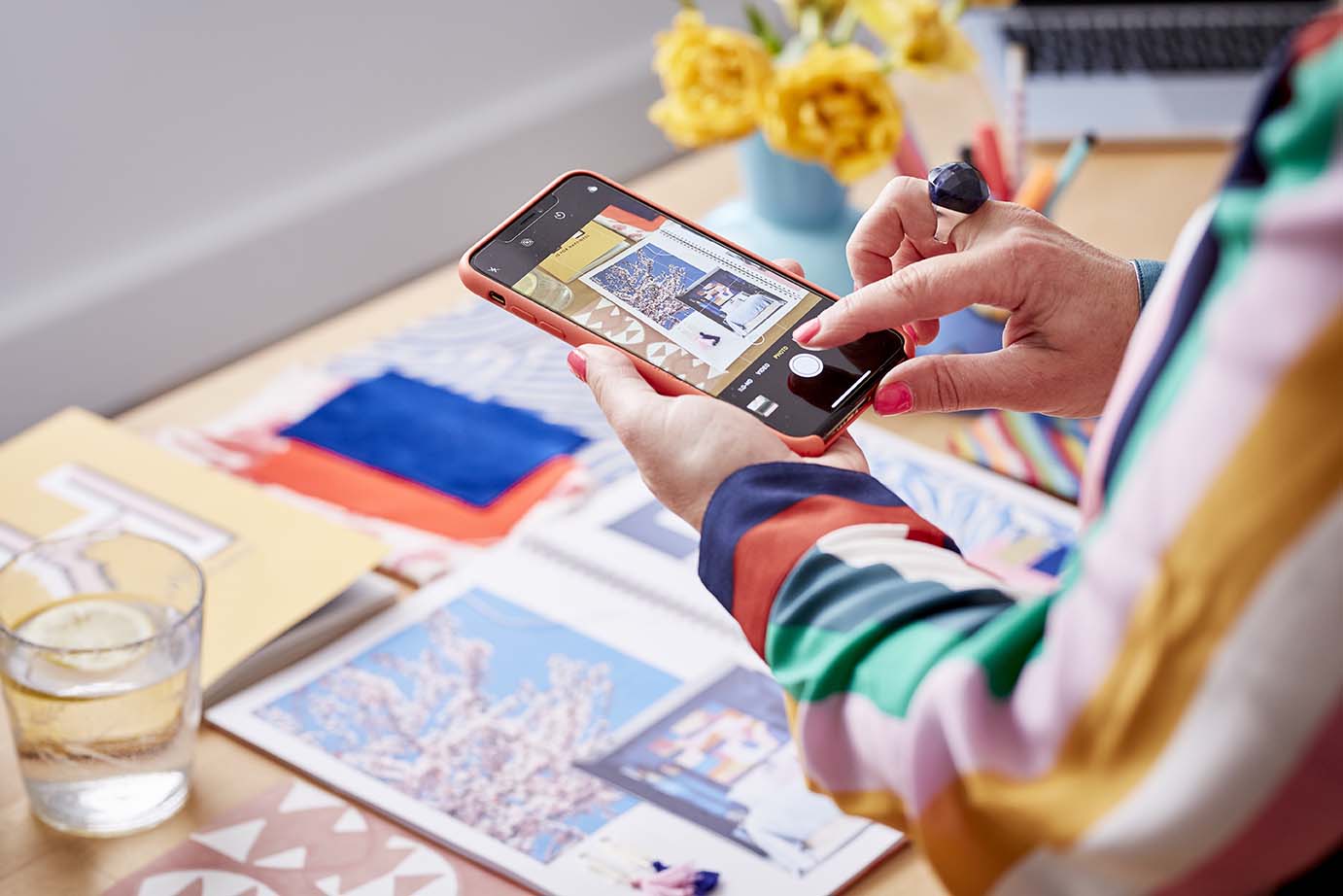How to mix patterns like a maximalist

Mastering Bold Prints and Creative Chaos
To fully embrace the maximalist style, you need to cultivate a love for patterns, textures, and bold prints like never before. And the best bit is, by embracing unexpected combinations you can reflect your own individual style and come up with something quite magical. This approach is as far away from the overly coordinated or matchy-matchy approach to pattern, as we are aiming for something far more fabulous!
When I talk about pattern, I think florals, stripes, checks, and geometrics, all colliding in a glorious display of colour and form. You may also consider botanicals, animal prints, arabesque, ikats, harlequin, polka dot, houndstooth, wiggles, and waves, to name a few more.
Whatever your pattern personality, to make a room burst with character, I like to celebrate the contrast, where harmony is born from a certain creative chaos. This approach isn’t for the faint-hearted, but when executed well, it results in a space full of life, style, and personal charm. The secret to mastering this maximalist style lies in understanding how to clash and combine different patterns while maintaining a cohesive overall feel. Let’s get into it.

One of my favourite chairs in “Woodland Floral” against this stunning wall mural “Into The Woods” both from my collection with Harlequin.
The Trio of Florals, Stripes and Checks
Florals are a staple of British interior design. Whether it’s large, blousy blooms or more delicate trailing vines, florals bring the feeling of a classic English garden into your home and are a timeless favourite. Stripes, by contrast, add a sense of order and structure. They can be bold and wide for impact or narrow and pinstripe for a more refined look. Stripes are incredibly versatile and can cut through the softness of florals to give a room some visual discipline. Checks, meanwhile, can evoke the comfort of country cottages and woollen blankets, adding a homely layer to your interiors.

See how I’ve mixed small-scale florals, with stripes and geometrics in my Conservatory. Vintage Kilim Rug: That Rebel House. Sofa: Covered in Element Aqua, Harlequin. Footstall: Sofa.com. 1980’s Vintage Sideboard: Vine Street Vintage. Rattan Lampshades: La Redoute. Scallop Tray: Addison Ross. Fabric sails, and fabrics on both armchairs: Sophie Robinson X Harlequin.
Play with Scale
Geometric patterns, inject a modern edge into a space filled with more traditional patterns like florals and checks. Think bold hexagons, zigzags, chequerboard or abstract shapes. These patterns add an element of the unexpected, making a room feel dynamic and contemporary. A good way to incorporate geometrics is through accent pieces like cushions, rugs, or even a statement lampshade. The key to combining geometrics with florals or checks is balance; geometrics work best when they’re used to break up the more intricate and detailed patterns, giving the eye a place to rest.
In addition to mixing patterns, playing with scale is crucial to the success of pattern clashing. Pair large-scale floral cushions on a sofa with a smaller-scale geometric print, or opt for a bold, oversized stripe on curtains alongside a floral wallpaper. The juxtaposition of scale is what keeps a maximalist room from feeling overwhelming. It’s about creating a visual rhythm that keeps the eye moving around the space.

I love how this bold horizontal stripe creates the element of surprise against this floral wallpaper in my kitchen. Curtains: “Paper Straw Stripe Citrine”. Wallpaper: “Wonderland Floral” both by Sophie Robinson X Harlequin.
Layer, Layer, Layer
When it comes to pattern, maximalism is all about layering and creating that feeling of richness. You’ll want to think of the textiles too. Velvet, linen, cotton, wool – each material adds its own texture and depth to a room. Pattern velvets can be used for plush sofas or armchairs, adding luxury and warmth, while linen works beautifully for curtains, cushions or upholstered footstools, providing a more relaxed, yet fresh feel. Woollen throws and cushions add that cosy, tactile quality that is essential for making a maximalist room feel inviting.
Another clever use of pattern fabric is in lampshades. A floral or geometric lampshade can subtly introduce pattern, casting beautiful shadows and adding an extra layer of interest to a room. Mixing fabric textures within the same pattern family—such as a velvet floral cushion paired with a cotton floral throw – adds depth without veering into monotony.

My maximalist master bedroom shows you how with a cohesive colour palette, you can clash patterns to make a space feel vibrant and fabulous. Wallpaper: “Wonderland Floral”, Headboard in fabric “Sherbert Stripe”, Cushion Fabric: “Woodland Floral” Bedspread fabric: “Meander” all Sophie Robinson X Harlequin. Lamps: Pooky. Vintage tables painted in “Heat” by Little Greene.
Embrace the Bold – More is More!
Wallpaper is where a maximalist interior can truly come to life. Don’t be afraid to go bold with floral or geometric wallpaper on all four walls, and even the ceiling too. If an all-over print feels too much for you, use it as a feature wall behind the bed or the sofa, or pick out a striking mural and contrast it with painted walls in a colour that connects to the paper. One of the advantages of wallpaper is that it can unify a room, pulling together the various patterns used on fabrics and accessories.
When it comes to flooring, rugs are another way to introduce pattern. A checked or geometric rug in a bold colour can anchor a room full of different patterns, providing a grounding element. Don’t forget the potential of patterned tiles in bathrooms, kitchens and hallways; a vibrant geometric tiled floor can make a statement and offer a hard-wearing, practical option that still adheres to the maximalist mantra of ‘more is more’!

Vibrant geometric tiles in my hallway proving that maximalist design is all about making a bold, stylish statement. Walls painted in “Lazuli” by Zoffany. Floor in Havanna Bauta cement tile by Claybrook Studio. Floral chest of drawers by Rockett St George. Artur lamp by Pooky. ‘March to the beat of your own drum’ framed mirror by Alex May Hughes.
How to make it all really work
While maximalism thrives on breaking rules, a few guidelines can help ensure your room doesn’t tip into chaos. The first rule to creating harmony when you are clashing multiple patterns is to ensure they share a similar colour palette. By keeping the colours harmonious, you allow the varied patterns to coexist without uncomfortably clashing.
The second rule is to attempt to theme the design motifs. For example, in my home all the florals and botanicals are British archive designs and typical of English country homes, of which my house is one. It would look odd to add a jungle botanical for example. I’ve added a little bit of the unexpected with more abstract prints like the wiggle fabrics which are more contemporary.
Lastly, balance is key. If you have heavily patterned walls, you may want to opt for more subdued patterns in your furniture or curtains, or vice versa. Understanding your own threshold for pattern is something only you can experiment with.

Understanding your own threshold for pattern is something only you can experiment with. Chair in Fabric “Wonderland Floral” and “Dappled Leaf” both from my collection with Harlequin.
Where to start
Start by choosing a hero pattern motif—this could be a large floral print or a bold stripe – and then layer in smaller, complementary patterns. Your hero pattern might be the main event, like a wallpaper or something smaller like a signature cushion. But this pattern will spin out and dictate your overall colour palette. The choice of prints you bring into your space will reflect your personal style, so don’t be afraid to seek out bold designs that speak to you. Whether it’s a daring floral wallpaper, a statement check rug or a leopard print armchair, each pattern adds its own story to the room, creating an individual look that feels distinctly yours.
If you’d like to learn more about designing a maximalist interior and refining your own design style check out my online course where I take you on a tour of my home and detail how every room was designed to maximalist perfection. This is a self-paced course which you can take in your own time, designed to help you explore your own creativity while giving you the framework to follow for successful results.








 After
From beige to boom! My bathroo
After
From beige to boom! My bathroo





